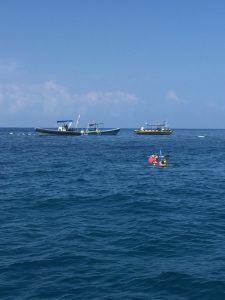On April 25, our class chartered a boat on the Kona side of the island of Hawaii. Within just a few minutes after leaving the dock, we encountered Hawaiian spinner dolphins in a local bay and a swarm of eager tourists attempting to swim with them. With over 70 dolphin-focused tours throughout the islands and a rapidly growing tourism industry, many people are excited by the opportunity to swim with these wild dolphins. However, tourists generally do not understand that they are disrupting a critical dolphin resting period.
Hawaiian spinner dolphins (Stenella longirostris) travel offshore to feed at night and return to shallow bays to relax during the day. With recent research by Julian Tyne (2015) estimating spinner dolphins are likely exposed to human activities during more than 82% of their resting period, scientists and conservationists are concerned the dolphins are not getting adequate rest. [i]

While observing tourists swim with dolphins on our class boat trip, I noticed some individuals chasing the dolphins and touching them. Although these people may think their actions are harmless, they are considered illegal harassment under the United States Marine Mammal Protection Act (MMPA) of 1972. Under the MMPA, Level B harassment includes disturbing marine mammal behavioral patterns, such as breathing, breeding, feeding or sheltering.
Within the MMPA, the United States National Oceanic and Atmospheric Administration (NOAA) is required to protect dolphins, porpoises, whales, seals and sea lions. Although the NOAA Office of Protected Resources has been working to establish regulations for dolphin tourism, gathering support from the state governments and the tourism industry has proven to be challenging. Currently, the Hawaiian state government supports implementation of an approach rule, meaning boats and people must maintain a distance of 50 yards from the dolphins. However, this would be difficult to enforce given the curious nature of spinner dolphins and their frequent changes in location.
Another management approach being considered is time/area closures. This would require temporarily closing portions or entire resting bays to boat tours. Although the Hawaiian state government is not keen on this idea, conservationists and some native Hawaiians support this regulatory measure. One of our charter boat guides stated, “I think time closures would be a better alternative than complete closures… Make part of a bay a no swim zone, then you can see if dolphins want to swim with people or not.” This same guide also ends his tours whenever there is a noticeable shift in dolphin behavior to avoid human interactions, but unfortunately not all guides have this environmental ethos.
In addition to regulatory action, continued research and educational outreach are also necessities. Measuring the levels of stress on the dolphins via hormonal cues, for example, could help quantify the impacts of human interactions. Furthermore, increased awareness among the public of the spinner dolphins’ daytime resting behavior could discourage some tourists from jumping in the water.
While ecotourism is economically important for the state of Hawaii, we must respect that these spinner dolphins, as well as other popular ocean creatures, are wild animals that need adequate rest and relaxation to thrive.
[i] Tyne, J. 2015. A Scientific Foundation for Informed Management Decisions: Quantifying the Abundance, Important Habitat, and Cumulative Exposure of the Hawaii Island Spinner Dolphin (Stenella longirostris) Stock to Human Activities. Murdoch University.
